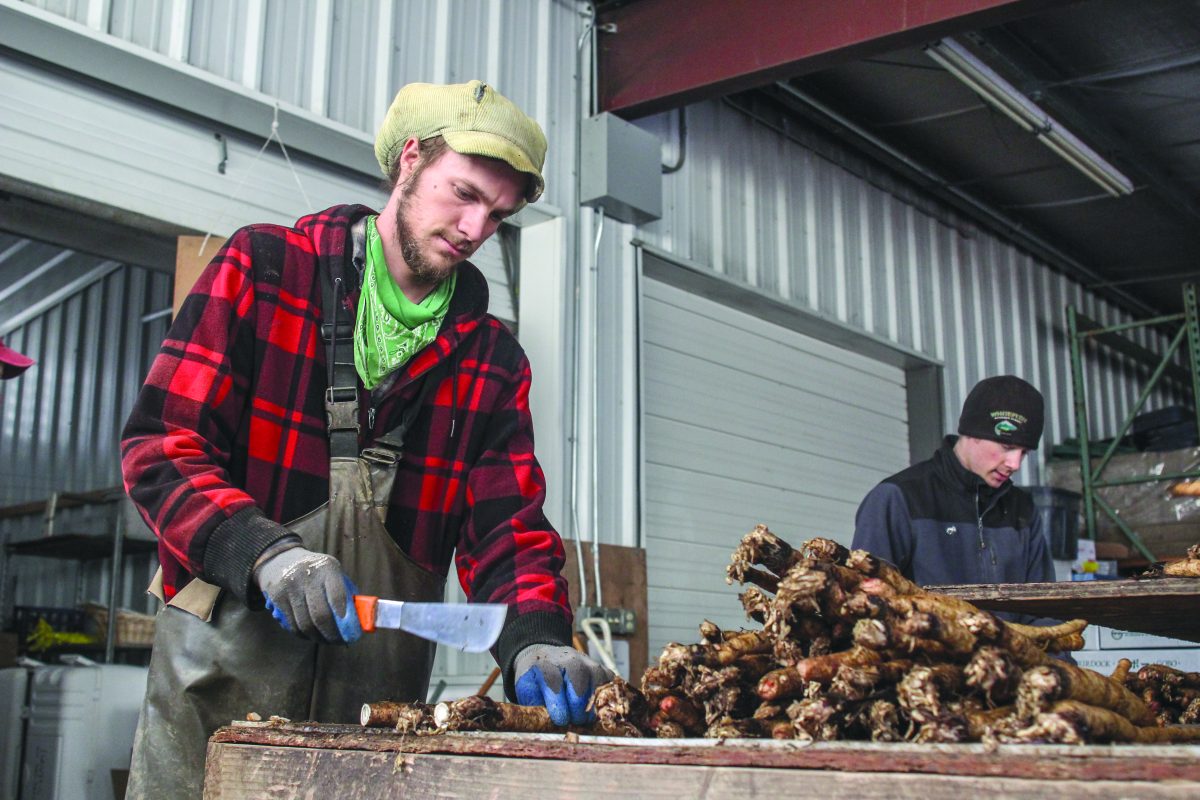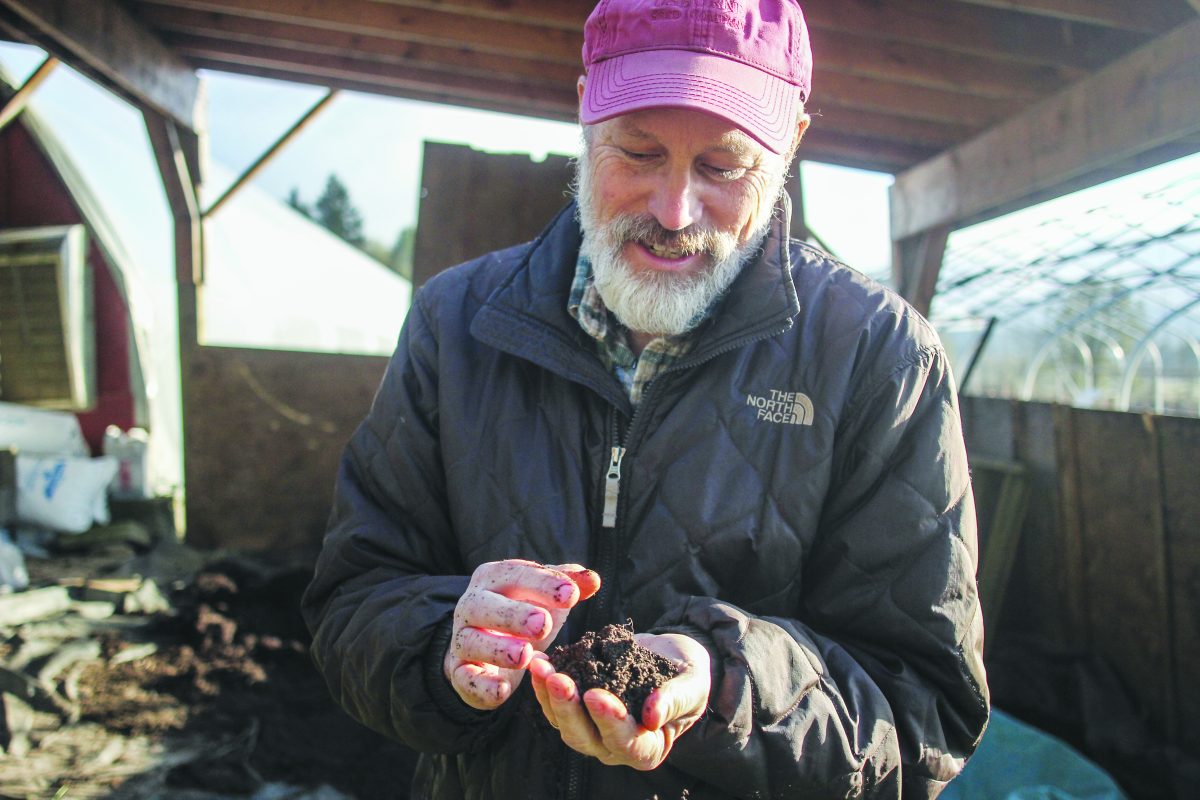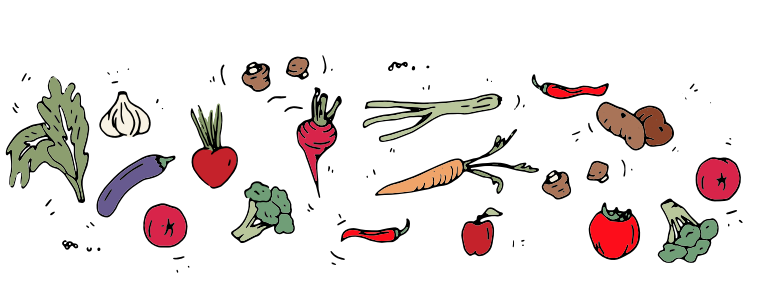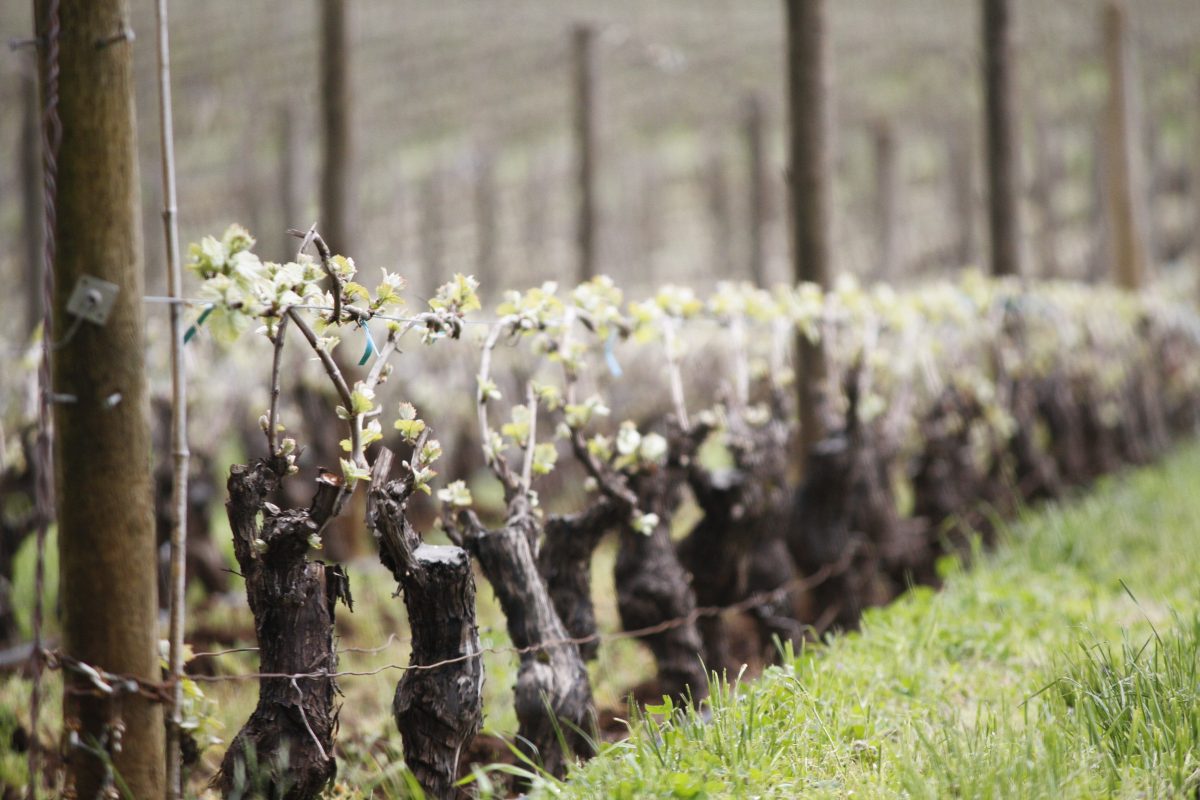Story by Brittany Nguyen
Photo by Tiffany Han
It may be the dead of winter in Oregon’s Central Willamette Valley, but it’s difficult to tell when looking at Winter Green Farm. It’s especially apparent on a rare sunny day in January, when the grass shines a healthy shade of bright green, and the roaring of trucks on the gravel mixed with the lively chatter of farmers fills the air.
Winter Green Farm’s co-owner Wali Via checks up on a group of four farmers expertly chopping burdock, a popular herb commonly used in Japanese dishes. The swiftness of the chopping and boxing doesn’t reflect earlier snowstorms that significantly ailed many crops in the region. Via’s age conveys a sense of wise authority over these younger farmers, but his relaxed demeanor and casual smile shows that he leads by example. After he talks to his employees, he goes out to the field to check on other budding crops, his daily routine during the winter.
“The kale was slammed during the storm,” the 68-year-old Via says as he runs his bare hands over the crop. He digs his fingertips slightly into the soil that he attends to meticulously. “The whole farm basically went dead. But look – the kale is starting to finally come back.”
But it’s not the work ethic, nor the 365-day capability of Winter Green that sets it apart from what most consider a conventional farm. What sets it apart physically is miniscule: about a half teaspoon per acre, in fact. It’s the philosophical aspects that make it easier to understand why Winter Green is different from most agricultural institutions. Winter Green Farm uses biodynamics, where the influences of cosmic forces are brought into harmony with the cropping actions done on earth.
For Via, biodynamic farming is the solution to a life path he sought when he was only 18. He was beginning his undergraduate education at Emory University in Atlanta, Georgia, but felt unsettled by the experience and by the city life he grew up in. However, he found a park on campus, where he began to feel in tune with nature.
“I got to experience the beauty and harmony of nature, but at the same time, everywhere I looked, I saw that harmony and beauty disrupted by the human hand that had come in,” Via says. “That’s what pushed me to find where the beauty and harmony came from instead of just seeing its destruction.”
A cross-country hitchhiking adventure led Via to Eugene, Oregon, with just five dollars to his name, where he had a couple farming friends who would later co-own Winter Green with him. He began to read every agricultural book he could get his hands on to completely immerse himself into the new way of life.
“I couldn’t find any reading that spoke to that connective place I found with nature,” Via says of his experience. “It was all hard and dry how-to. And then I ran across a book written by some biodynamic authors, and I said, ‘Aha! Here’s someone that’s experiencing what I’m experiencing.’”
So Via quickly found a small Northwest group now known as the Oregon Biodynamic Group and landed a job at Winter Green Farm 35 years ago, never questioning the beliefs instilled in this unique way of farming. He now spends his days roaming about the vast acres of his property, carefully inspecting crops and paying special attention to the health of the soil and the cows that produce the fertilizer.
Biodynamics has been around since 1924, when anthroposophy philosopher Rudolf Steiner gave a series of lectures to rekindle ancient agricultural efforts of stewardship. It’s a modern take on the origins of being in harmony with the land, soil, and outside cosmic forces using mixed potions spread across the crops. The lectures are complicated, but the principle is basic: the term biodynamic literally means “life force”. Though many disregard this unique philosophical view on agriculture, calling it a real-life take on magic that lacks proof of quantitative results, some conventional farmers admire the attention to detail and spirituality that this distinctive practice requires.
Via explains that the difference is qualitative rather than quantitative. He claims that it’s the taste and oftentimes storability of a plant that make the difference.
“Unfortunately, we don’t have good scientific methods of measuring,” Via says. “It’s usually based on taste tests, but that’s very [subjective]. For example: carrots. How do you scientifically measure the quality of its taste? I’d say this has been the nemesis of biodynamics in some ways.”
Winter Green, which Via owns with his wife and two other families, boasts one of the largest lands in Oregon practicing this technique, with over 35 employees tending to 170 acres of crop. As with all agricultural techniques, biodynamic practices can be applied on different levels depending on the farmer’s wants and needs. Though Winter Green takes on the more esoteric-spiritual approach, other farms take it on a more practical level, leading to confusion with organic farming. What really sets a biodynamic farm apart from an organic one are the unique mixtures of herbs and animal compost used spiritually. Think of them as influencers, if you will. Spread throughout the farm, these influencers can bring the soil in harmony with the land and with the alignments of the planets throughout the year.
These mixtures, which biodynamicists call preparations, are made of nine ingredients, numbered 500 to 508. Each ingredient is in itself made up of its own preparations. Again, the level that each biodynamicist takes varies, and unfortunately, some of the more extreme varieties are what makes people skeptical of this practice.
University of Oregon urban farm director Harper Keeler has studied biodynamics and has analyzed these methods. Though he doesn’t practice it, he is quick to defend what he considers radical farmers, while understanding the skeptics’ view.
“So you get your bucket, you put yarrow in it and spin it fifty times in one direction before you contemplate on the vortex,” Keeler says of some of the more extreme adaptations of biodynamics he’s heard that includes the weedy flower. “Sure, it sounds weird. But it’s just an extra little ritual added. If you think about it on a faith base, it makes enough sense.”
The most commonly used preparations normally involve stuffing cow manure into the horn of a cow with various ingredients such as quartz, yarrow blossoms, dandelion flowers, and other herbs and flowers.
Steiner explains the cow horn in one of his lectures, stating, “The cow has horns in order to reflect inwards the astral and etheric formative forces, which then penetrate right into the metabolic system so that increased activity in the digestive organism arises by reason of this radiation from horns and hooves.” Every year, Winter Green hosts a gathering of all members of the Oregon Biodynamic Group to make these preparations together. They then bury the horn into the ground about 40-60 cm below the surface. There’s nothing scientific about the placement of these objects. The reasoning solely aligns with the spiritual-ethical-ethological approach of this agricultural practice.
“Biodynamics has had a difficult time getting footing in the US in terms of acceptance because of this,” Via said. “When you start throwing in fairly wild ideas that are more spiritual in orientation, that can be off-putting to many people.”
Keeler, as an outside observer, fully agrees with this.
“People are cynical because we are generally programmed to think that western science has to prove why it works,” Keeler said. “That you have this many grams of something, and it grows that much more. It has to be proved.”
When the Oregon Biodynamic Group meets, its members make preparations that help sensitize the earth to the influence of the cosmic rhythms that the earth is both surrounded by and is part of. Oftentimes they use an astrological calendar to find the right alignments with certain planets.
“Think about it,” Via says. “When we grow a plant in the ground, we can’t just concentrate on the small square of patch where the seed was buried. We have to look at that tree over there and see how its shadow could affect the plant. That’s exactly how biodynamics works: looking at everything in a broader sense.”
It may sound unusual, but that doesn’t mean it should be completely disregarded.
“It doesn’t do any harm, so people shouldn’t be so against it.” Keeler says. “Sure, there’s no way to prove it works. That doesn’t mean it doesn’t. All it does is demonstrate a heightened sense of stewardship. And it makes things exciting.”
In addition to these preparations, Via explains the importance of using self-producing fertility, rather than outside compost sources to support the sustainability of the soil.
“In his lectures, Steiner stressed that importing fertility onto the farm should be viewed as bringing medicine to an ailing organism,” Via said. “A healthy ecosystem means being self-sustaining.”
To Via, viewing a farm as a living organism is one of the key principles of his personal beliefs about biodynamics. In today’s scientific terms, a farm is seen as a local ecosystem. But in biodynamic philosophy, it’s much broader than simply seeing it as biological interconnectivity because it extends into the spiritual realm as well, with forces unseen and immeasurable.
“We’re right on this border now, where 95 percent of society says, ‘OK, out the door,’” Via says. “So I tend to emphasize the qualitative side of biodynamics, that the proof is in the pudding.”
On the flipside, Keeler brings to light a legitimate reason for the cynicism. “There are those that believe these people just put a little extra on their soil just to tack on the name ‘biodynamic’ and be able to charge more,” Keeler said. “And in some cases, some people charge more because it takes more time to do. And in this capitalistic society, people have the assumption that everyone is just in it for the monetary reason.”
Though that could be the case for some biodynamic farms, most truly see it as a practice that gives them a purpose. Biodynamic farming benefits the farming world as a whole, revisiting old agricultural mantras that have been lost as the demand for food grows. Rather than viewing land as something to manipulate in order to produce mass quantities of food, biodynamic farmers see themselves as stewards of the land. They strongly believe in the ethical treatment of their agriculture and their animals.
Keeler, along with many other farmers throughout the valley, praises Via for his extreme attentiveness to his soil, claiming that Via’s soil is the best in the area. He also has respect for the work ethic of biodynamic farmers in general.
“These people that are so into it, so intent on perfecting every little detail to align with their beliefs,” Keeler said. “And I don’t know if it’s because of the faith or just the coincidental default setting of these farmers. So to those who are cynical: in that respect if it gets you really into studying and watching all the time and it’s the methodology, then it’s really cool.”
In short, biodynamic farming is an extreme way of following a cycle – something that every successful farmer does. Their techniques just tailor more towards a larger meaning.
“I think that human nature is such that many people find it easier to disregard something that doesn’t fit into their paradigm than it is to approach it with an open mind and consider the validity of it,” Via says. “Me? I prefer to walk in life seeing that everything is possible. If I’m absolutely convinced that something needs to be disregarded, fine. But with an open mind; life is just richer.”
Via handles each soil preparation with extreme care, making sure the ingredients are in harmony with one another.















